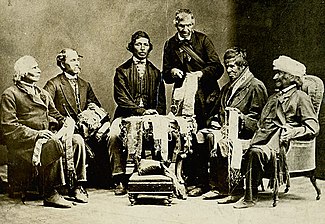George Henry Martin Johnson
| George Henry Martin Johnson | |
|---|---|

Chief George Johnson, seated centre, with anthropologist Horatio Hale on the left, and fellow chiefs of the Mohawk nation
|
|
| Born |
Deyonhehgon October 7, 1816 Bow Park, Grand River, North America |
| Died | February 19, 1884 (aged 67) Grand River, Canada |
| Nationality | Mohawk |
| Other names | Onwanonsyshon |
| Citizenship | Mohawk |
| Alma mater | Mohawk Institute |
| Occupation | Interpreter |
| Known for | Six Nations chief |
| Title | Chief |
| Spouse(s) | Emily Susanna Howells (m. 1853–84) |
| Children | Pauline Johnson, 3 others |
George Henry Martin Johnson (Onwanonsyshon) (October 7, 1816 – February 19, 1884) was a member of the Wolf clan and selected as a hereditary chief of the Mohawk of the Six Nations in Canada; he also served as an official interpreter and informal diplomat between the Mohawk and Canadian governments. His home of Chiefswood, built in 1856 on the Grand River, has been designated and preserved as a National Historic Site; it is the only First Nations mansion from the pre-Confederation era.
Johnson was born at Bow Park on the Grand River on the Six Nations of the Grand River First Nation near Brantford in 1816. The Wolf clan members had founded the Reserve after resettling from New York during the American Revolution.
He was the son of John Smoke Johnson, a Mohawk Bear clan chief, and Helen Martin, a Mohawk whose Dutch mother Catherine Rolleston had been captured as a girl and adopted and assimilated into the Wolf clan. Her father Ohyeatea (George Martin) was Mohawk. The couple lived with her parents until after their first child was born, in Mohawk custom.
George Johnson was educated at the Mohawk Institute, where he became fluent in English as well as Mohawk.
In 1838, Johnson was hired by the Reverend Adam Elliot as an interpreter. In 1840, he became interpreter for the Anglican mission at the Reserve. He became influential in both the English and Mohawk communities.
In 1853, Johnson married Emily Susanna Howells, a native of England whose family had immigrated to the United States in 1832. She was the sister-in-law of Reverend Elliot and a cousin of the American author William Dean Howells. Both families, and the Native community in general, opposed Johnson's interracial marriage to a white woman. The Mohawk resented that under Canadian law, Howells as Johnson's wife would gain status as a Native, with a right "to a portion of her band’s annuities and other benefits." Under the Mohawk matrilineal kinship system, her children would have not fully belonged to the tribe as they would not be part of any clan. Reverend Elliot refused to perform the marriage ceremony, so the couple found another Anglican priest who would.
...
Wikipedia
